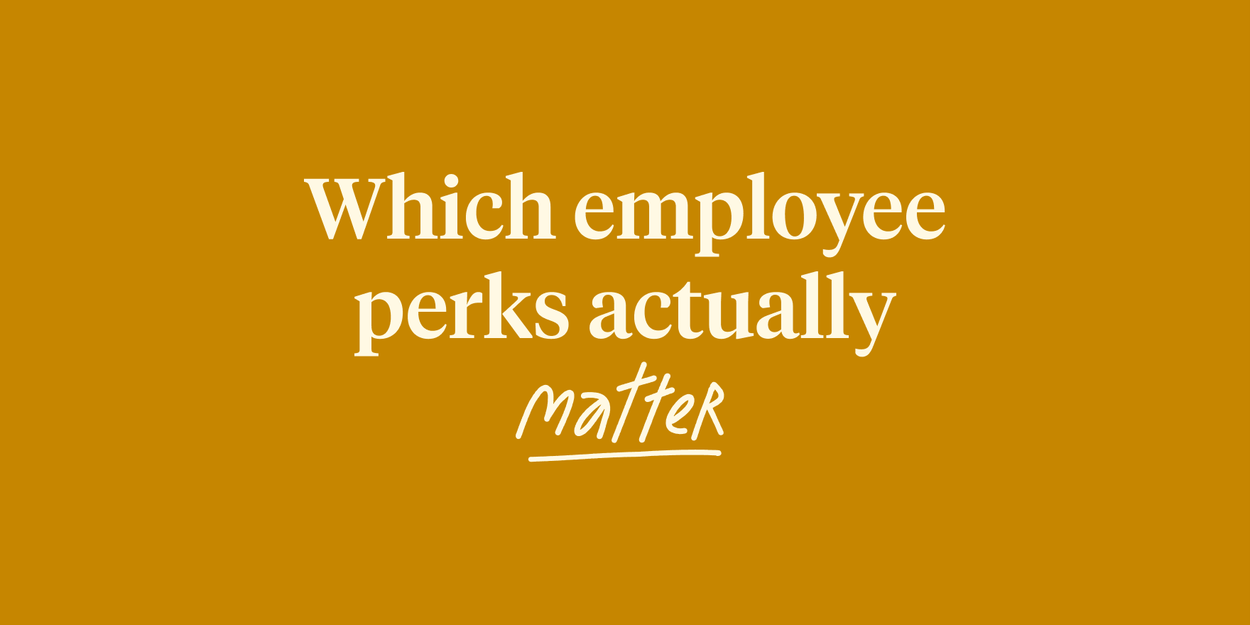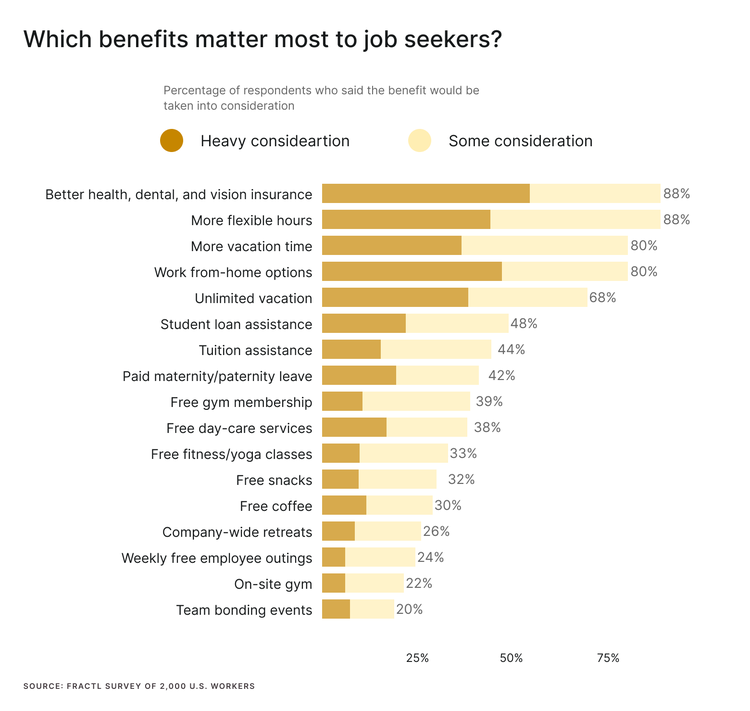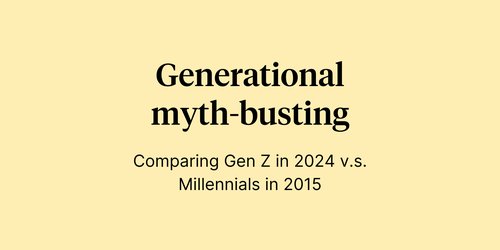
Employee perks: What your people actually want

For years, organizations have invested in quirky workplace perks in an effort to stand out from their competition and attract top talent. For instance, Google offers free gourmet meals and massages, while Facebook boasts an on-site barbershop and spa. However, the age of ping-pong tables may be coming to an end as employees express less interest in fun workplace benefits and focus instead on perks that actually improve their experience at work.
The ongoing Great Resignation shows us that in a world where remote and hybrid work is the norm, unique perks that are based in the traditional office feel less significant than having work-life balance and consistent communication. The pandemic has led many people to reflect on what really matters to them. Ongoing racial and social movements have inspired organizations and people leaders to focus more on diversity, equity, and inclusion in the workplace. These shifts in perspective have increased employee demands for more meaningful benefits.
Flashy or unusual perks may attract attention, but they don't significantly contribute to your organization's employee experience. This article explains how organizations can take a people-centric approach to employee perks, and we share a few examples of the kinds of perks employees are looking for now.
Why choosing the right employee perks matter
Many companies leverage employee perks as a strategic recruiting and hiring tool. Like compensation, perks are indeed a huge consideration for many candidates). The data collection company Morning Consult surveyed 1,121 employed U.S. adults about incentives that would make them consider joining an organization immediately. 29% of respondents mentioned things like paid time off and insurance coverage, making benefits the second most enticing factor after salary (31%).
Employee perks can also be an important part of an organizations' retention strategy. Comparably found that 79% of workers from the top-rated large companies and 83% of employees from top-rated small and medium organizations said that benefits play a part in their decision to stay in their company. However, as Comparably also notes, the top-rated companies offer benefits that cater to the full spectrum of an employee's life – something ping-pong tables and slides don't quite deliver.
This data is backed up by the Harvard Business Review, which found that employees placed a high value on benefits that improved their work-life balance, such as flexible hours, more paid vacation time, and work-from-home options. On the other hand, benefits that do not significantly impact an individual's lifestyle and finances were the least coveted by survey respondents. These include things like free food, coffee, and company-sponsored gatherings like team-bonding activities and retreats. Below is a chart, which we’ve reproduced from the original article, that summarizes the benefits most valued by job seekers.

While this isn't to say that benefits like team bonding events and on-site gyms aren't valued by employees, it's important to understand they aren't the most valuable ways to improve employees' experiences at work. Without deeply thinking about employee wellbeing and what your employees actually need to thrive, your organization may end up paying for perks in the hopes of attracting new talent instead of driving the engagement and retention of existing employees. Only by being intentional and holistic about your employee perks program can you unlock benefits such as increased productivity, higher levels of engagement, and lower levels of burnout.
The best way to pick perks is to listen to your employees
To maximize the benefits of your employee perks program, simply ask your employees what they want. There's no need to guess or copy how another company runs its employee perks program. Each organization is unique, so it follows that each organization's workforce would prioritize different things.
One easy way to gather input from employees is to conduct a survey and ask how they feel about your current benefits offering. Concrete data is the best way to uncover what your people like or dislike about your current offering, as well as to uncover disparities in employee sentiment across different groups. Some engagement solutions, like Culture Amp, offer a Benefits template for assessing existing benefits and perks, as well as inquiring about preferences and interests in new benefits and perks.
Three things to keep in mind when choosing employee perks
While the best way to determine the most valuable employee perks is to listen to your employees, there are several considerations to keep in mind. As you go through the process of redesigning your employee benefits and perks program, we recommend keeping these three points at the forefront of your strategy.
1.) Don't confuse office perks for culture
A positive company culture keeps employees engaged and invested in your organization by creating an environment that encourages employees to authentically show up as their best selves. However, it would be amiss to think that the office and its perks are synonymous with culture. Perks can reinforce culture, but they should not be mistaken for culture itself.
For example, Jonathan Johnson, the CEO of Overstock, said that the company made the mistake of confusing office perks with culture when the company moved offices in 2016. The $100 million campus was complete with an on-site medical clinic, a game room, and even a green room to grow fresh food for the on-site dining area. However, Jonathan and other leaders quickly realized that while the office's perks may have helped recruit employees, it did not retain the employees in the long term. "It was a 'proxy for culture,'" Johnson reflects. "'Office space is not culture. Ping-pong tables are not culture. Subsidized meals are not culture."
Takeaway: When redesigning your employee benefits and perks offerings, ask yourself which employee benefits reinforce your company's culture. For example, if one of your company values is to "authentically show your best self at work," determine whether or not your current benefits can support your employees in their most difficult and vulnerable moments (e.g., bereavement leave).
2.) Think inclusive
While having an arcade game room in your organization's office may look cool to you, some perks may actually alienate or exclude your employees.
Always consider equal access when choosing employee benefits, or you run the risk of only appealing to certain communities of people within the organization. For example, employees with physical disabilities may feel uncomfortable or left out of a company-wide yoga class. In-office perks like an on-site gym might not seem like a perk at all.
In contrast, the option for remote work is not just a popular perk among employees during the Great Resignation, but one that can help break down key workplace barriers for people in the disability community, for whom remote work can be the difference between being able to work or not.
Elizabeth Tippett, who researches behavioral ethics and employment law at the University of Oregon's School of Law, says, "It's a good time to stop and think about the equity implications. Is the way the company is investing in workers helping some workers over other kinds of workers?"
Another example of being inclusive when designing employee perks and benefits is by including the LGBTQ+ community in parental leave policies. If you're already providing or thinking about providing paid parental leave, doing so expansively and using inclusive language can be a move toward equity for LGBTQ employees. Lauren Brody, journalist, speaker, and head of The Fifth Trimester movement has found that the language of "primary caregiver" and "non-primary caregiver" isn't helpful to LGBTQ people. She clarifies, "We're all primarily responsible for taking care of the next generation. What I see happen too often is couples have access to different amounts of leave because they are 'primary' versus 'secondary,' because they are 'mom' versus 'dad.'"
Takeaway: Taking an inclusive approach when designing your employee benefits and perks helps ensure that you have the full spectrum of your employees' best interests in mind. While some company perks may sound great on paper, they may not be as beneficial or accessible to folks from certain communities or historically marginalized backgrounds.
3.) Employee wellbeing is key
No matter if you're a big or small organization, it's worth investing in the key perks that matter to employees, such as their health and the ability to be themselves at work. Wellbeing at work is about optimizing both mental and physical health, making your employees feel well-rounded and refreshed.
The pandemic has exacerbated the mental health challenges of many employees. One survey, conducted by the Conference Board, found that 59% of employees named stress and burnout as their top concern for workplace wellbeing. As the demand increases for workplaces where mental health is a primary focus, people leaders must take notice and take action.
Takeaway: Providing mental health benefits doesn't just improve recruiting and help you retain your best employees, it benefits the entire organization. Mental health – whether positive or negative – is a constant for all of us. Just as you'd want your workforce to be physically well, each person's mental health also deserves attention. Plus, when people leaders recognize the importance of mental health and address its stigmatization, they make it possible for their employees to perform better.
Looking Ahead
Some companies have a reputation for offering over-the-top perks in a bid to stand out from the competition and attract talent. While a game room for your employees or nap pods throughout the office may attract attention, employees are looking for perks that really matter to them and reflect their values. Listening to your employees can help your organization determine what they truly want from you.



